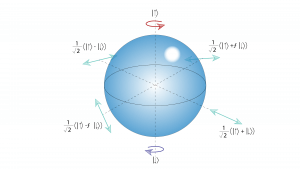Summary
As monolayers, transition metal dichalcogenides (TMDCs) – such as tungsten diselenide (WSe2) – become direct-bandgap semiconductors capable of emitting light. Compared to conventional direct-bandgap semiconductors, such as III-V semiconductors like GaAs, excitons (quasiparticles made of an electron hole bound with an electron) and single-layer TMDCs (SL-TMDCs) have much stronger binding energy. Excitons and SL-TMDCS also have an extra degree of freedom called “k-valley index” or “pseudospin”, which couples with their spin in the presence of light. Due to the way the spin and valley degrees of freedom couple together, excitons in SL-TMDCs can act as a two-level quantum system, whose quantum state can be initialized and controlled with photons of specific polarization, either collectively or as individual excitons confined in quantum dots. To utilize these two-level quantum systems as solid-state qubits in a quantum device, the spectral and temporal dynamics of SL-TMDC excitons in the presence of electric and optical fields needs to be investigated. However, some of the exciton processes in SL-TMDCs happen at timescales that are beyond the resolution of streak cameras used for studies of excitons in conventional semiconductors. To overcome this problem, this research will use femtosecond photoluminescence up-conversion (fsPLupC). This technique relies on sum frequency generation that arises when the photoluminescence signal overlaps with a reference femtosecond (fs) pulse inside a non-linear crystal. It can reveal both temporal and spectral information about the studied processes, potentially with a resolution better than 100 fs. This work will provide a greater fundamental understanding of TMDC monolayers and explore their potential use as ‘valleytronic’ based quantum devices.

Figure 1. Bloch sphere depiction of the optical addressability of bright excitons in a Single-Layer TMDC. Bright excitons with pseudospin ├ |↑⟩ or ├ |↓⟩ are created (annihilated) via absorption (emission) of a right-handed or a left-handed circularly polarized photon (red and blue arrows, respectively). The equator corresponds to equal superpositions of bright excitons in the two valleys and are therefore generated by absorption of linearly polarized photons denoted by green arrows.
Related Content

Portable Quantum Dot Measurement System
Summary Detecting heavy metals in water is essential to ensure clean drinking water and appropriate regulatory decisions following an accident (e.g., a spill) or an emergency. Traditionally, high-sensitivity detection of heavy metals requires bulky and costly (to purchase and operate) lab-based instruments. We propose developing a palm-sized, element-specific, highly-sensitive, battery-operated, smartphone-controlled system for on-site measurement […]
July 21, 2022

Silicon Platform for Electron Spin Qubits
Summary Scaling solid-state quantum processors to a useful threshold while maintaining the requisite precision in quantum control remains a challenge. We propose a quantum metal-oxide-semiconductor (QMOS) architecture operating at cryogenic temperatures that is based on a network/node approach as a means to scalability. By working with QMOS, we benefit from the deep investments and […]
December 7, 2018
Novel Superconducting Qubits for Error-Corrected Processors
Summary In this project, we develop novel superconducting qubits for error-corrected processors to enable large-scale quantum computing. Our design efforts will specifically target error-corrected architectures through a variety of paths. Possible features will include built-in parity measurements and the use of bosonic codes, such as Fock state and Cat codes, as our starting focus. Early […]
June 26, 2019


